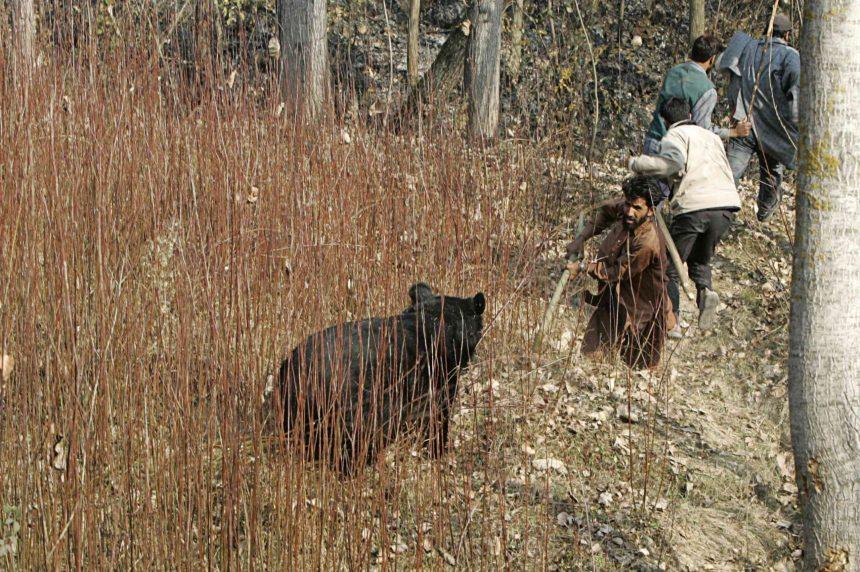
Human-Wildlife Conflict: 264 Lives Lost In 17 Yrs In Kashmir
Figures reveal that from 2006 to March 2024, 264 individuals have fallen prey to the man-animal conflicts, with hundreds getting injured.“The toll is staggering. As 14 deaths and 65 injuries were recorded in 2022-23, 16 deaths and 182 injuries were reported from 2023 to March 2024 alone,” an official
from the wildlife department said.
Experts believe that the encroachment of wildlife habitats by humans has led to an increase in such incidents.
Rao Farman Ali, a researcher, said that the areas once exclusively inhabited by wild animals are now being encroached upon by human populations, resulting in attacks on humans.“The unplanned urbanization and governmental negligence in implementing proper procedures to protect wildlife and forests are contributing factors,” he said.
He said that deforestation over the decades has significantly impacted wildlife, whereas in ancient times, people used to coexist with animals with fewer incidents.
Read Also Kashmir Grapples With A Surge In Leopard Attacks Leopard Injures 5 In Central Kashmir, Later Captured Alive“There is a need to protect forests and catchment areas should be made free from human interference. There is an importance of raising awareness among the public to avoid encroaching on wildlife zones and ensuring that animals have their own habitats,” Ali said.
Intisar Suhail, senior wildlife expert and wildlife warden in Baramulla district said that they have covered almost all the areas where they received reports of leopard attacks or livestock damage. However, there are still several areas close to forests where leopards attack and then retreat back into the forests.
He said that to address the issue, the department has installed cages in two or three areas, and“we are hopeful to gain control over the situation as soon as possible.”
Suhail also expressed concern for the people living near the forests, emphasizing that they are vulnerable and lack protection.“Most of the attacks take place in the dark,” he said.
The officer said that they haven't ensured proper security measures for the livestock, which might be why leopards are easily able to attack them.
He said the department has conducted awareness programs in many areas to educate people about the importance of self-protection and safeguarding their livestock.
Suhail said that they have received calls from various locations and their teams are actively working to address the issue and protect the livestock.
Regarding human habitats, he said that the department is prioritizing its safety.“We are facing challenges, particularly in villages located within the forests. Nonetheless, efforts are being made to ensure the safety of everyone,” he said.
Divisional Commissioner, Vijay Kumar Bidhuri, has called for a well-coordinated strategy to tackle attacks by wild animals, particularly leopards and bears, across the valley. He emphasized the need for a centralized helpline to receive timely information for a swift response. Bidhuri has directed the Wildlife Department to strengthen the capacity of its staff, enhance logistics and operate Control Rooms at the district level.
The Divisional Commissioner also urged police personnel to assist wildlife teams when needed, ensuring crowd management and the safety of civilians. He emphasized the importance of coordination between district administrations, police, wildlife department, community leaders, lumberdars, chowkidars, and shepherds in capturing wild animals and processing factual information.
To prevent leopards from venturing into habitations, Bidhuri advised people to keep areas clean and dispose of waste properly, preventing stray dogs from being attracted to residential areas. He also urged residents not to leave their children unattended during dawn and dusk and advised them to move in groups in confirmed wild animal sitting areas
Regional Wildlife warden Pradeep Chandra Wahule said that Leopards are protected animals and need to be preserved.“But things change when they attack humans. We have to tranquilise them or kill them as per the requirement,” he said.“It is the humans who are forcing the leopards to change their behaviour. Leopards love to eat dogs. When we leave food, especially waste food scattered around our homes, that invites dogs. When the dog population increases, Leopards change their behaviour and enter residential areas as they love to taste dogs.”
He said,“If we deal with the garbage disposal properly, there will be no easy access of food to wild animals. So we need to dispose of the food waste properly to prevent the entry of leopards into residential areas.”
As far as the bears, he said that they love to eat fruit from the nearby orchards.“When there is population explosion as we see residential houses near the orchards, after eating the fruit, bears enter the residential areas,” he said. Chandra said that there are a lot of steps that the department has taken to prevent the entry of wild animals into residential areas.“There is a need for collective effort,” he said.
Follow this link to join our WhatsApp group : Join Now
| Be Part of Quality Journalism |
| Quality journalism takes a lot of time, money and hard work to produce and despite all the hardships we still do it. Our reporters and editors are working overtime in Kashmir and beyond to cover what you care about, break big stories, and expose injustices that can change lives. Today more people are reading Kashmir Observer than ever, but only a handful are paying while advertising revenues are falling fast. |
| ACT NOW |
| MONTHLY | Rs 100 | |
| YEARLY | Rs 1000 | |
| LIFETIME | Rs 10000 | |
CLICK FOR DETAILS

Legal Disclaimer:
MENAFN provides the information “as is” without warranty of any kind. We do not accept any responsibility or liability for the accuracy, content, images, videos, licenses, completeness, legality, or reliability of the information contained in this article. If you have any complaints or copyright issues related to this article, kindly contact the provider above.






















Comments
No comment